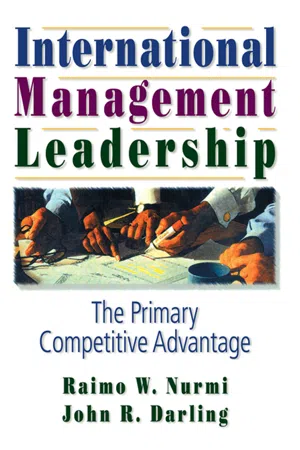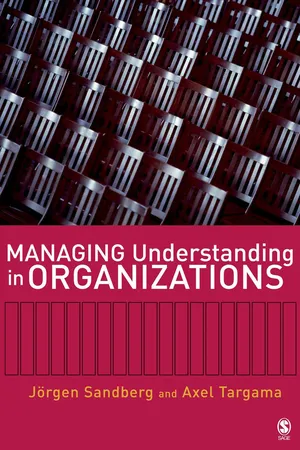Business
Managers
Managers are individuals responsible for overseeing and coordinating the activities of a team or department within an organization. They are tasked with setting goals, making decisions, and ensuring that resources are effectively utilized to achieve desired outcomes. Effective managers possess strong leadership, communication, and problem-solving skills to drive productivity and success within their teams.
Written by Perlego with AI-assistance
Related key terms
8 Key excerpts on "Managers"
- eBook - ePub
Managing Information & Systems
The Business Perspective
- Adrienne Curry, Peter Flett, Ivan Hollingsworth(Authors)
- 2006(Publication Date)
- Routledge(Publisher)
Managers set and monitor organisational objectives by allocating human and material resources and directing operations. They bring together the individuals in an organisation with its goals and needs, establishing individual and collective responsibilities to achieve what is necessary for the business. Managers have a variety of organisational roles and perform a number of functions, but essentially they are all decision-makers.The importance of good management cannot be over-emphasised; it frequently determines business success or failure. Good management has two criteria, which must be carefully balanced to ensure optimisation of available resources. Managers have to be efficient, i.e. accomplish tasks in the best possible way, and effective, i.e. make sure the tasks they are performing are the right ones. A manufacturer of furniture could produce much more elaborate and attractive items by disregarding materials and labour costs, but this would be inefficient management. Similarly, service organisations which spend a great deal of time and money perfecting aspects of their service that are relatively unimportant to their customers are managing in a highly ineffective way. Poor management is often manifested in both inefficiency and ineffectiveness or ineffectiveness obtained through inefficiency.Figure 3.1 Levels in the organisationOrganisational members can be divided into the two principal categories of operatives and Managers. Operatives work directly on tasks with little if any responsibility for overseeing the work of others. Managers, on the other hand, tend to direct the activities of other people and can be considered on three broad levels, outlined in the following list, with operatives making up the fourth level, as shown in Figure 3.1 - Franz Schmithüsen, Bastian Kaiser, Albin Schmidhauser, Stephan Mellinghoff, Karoline Perchthaler, Alfred Kammerhofer(Authors)
- 2015(Publication Date)
- Routledge(Publisher)
Business management deals with multilayered problems within a complex, often unpredictable, environment. It requires a willingness to engage in a continual learning process and take entrepreneurial risks. It presupposes an ability to quickly recognise and evaluate changes both in the company and in its business environment. In this sense, management is an important prerequisite for deliberate entrepreneurial action. A qualifying and motivating factor in the work of active, self-confident Managers is the search for innovation. Management above all means having a talent for leadership and for persuading employees to develop cooperation and implement shared goals making the company successful.Management derives from the Latin expression manum agere , ‘to lead by the hand’; it evolved to maneggiare in Italian and manier in French, with the meaning of guiding or, in a more general sense, handling a particular situation and leading an activity (Kluge 1975; Schneck 2006). Initially used in American English to refer to the work of organisers, agents and coaches working for artists or competitive athletes, it was introduced into other languages mainly in the second-half of the last century. When a new word is adopted from a foreign language, the activities it describes often take on new meaning. Today, management is more comprehensive and versatile than just leadership and guidance: it gives greater emphasis to active design, prospective activity relative to expected changes and personal responsibility for the consequences.Management is a process of decision making based on systematic information retrieval and analysis of the internal and external factors that determine the situation of an organisation or company (Bea and Haas 2005; Steinmann and Schreyögg 2005). Management activities structure business opportunities, identifying goals and possible solutions. They divide decision-making processes into phases for analysing complex situations and examining alternatives.General management practices address problems at the level of the company as a whole. However, business management also addresses the constituent entrepreneurial activities of the company, such as production, marketing, logistics, controlling and human resources. Although modern management practices have been developed mainly for commercial companies, they are not limited to the private sector. In public institutions and administrative bodies as well, a sound and comprehensive knowledge of management is an indispensable prerequisite for targeted and efficient action. The use of management tools has become increasingly common for publicly owned forests. A special case is the management of large forest estates owned by the state, which present in many ways pure business challenges rather than administrative or policy challenges. To implement this type of management approach, the public administration system must establish suitable conditions.- eBook - ePub
Making Sense of Organizational Learning
Putting Theory into Practice
- Cyril Kirwan(Author)
- 2016(Publication Date)
- Routledge(Publisher)
The role of the line manager as a facilitator of workplace learning has perhaps only been recognized relatively recently. Given that the job of the manager has undergone many changes since the end of the nineteenth century when it was first identified as a field of expertise in itself, it is not always easy to define. Various perspectives (Stewart 1985; Drucker 1993) describe Managers’ responsibilities in terms of objective setting, planning, decision making, organization of structure and work, motivating, communicating, measurement and control and development of self and others. More recent classifications, for example, Gosling and Mintzberg (2003), have described the role as managing one’s self, managing one’s relationships with others, managing the context, managing organizations and managing change. Whatever the classification, it would seem clear that a manager’s job comprises a variety of roles and tasks that must be integrated for effective performance. Managers’ ability to perform depends also on the cross-functional networks to which they belong, rather than their position in the hierarchy, as organizations become flatter, with increasing importance being placed upon external relationships as sources of power and influence, and even of career development.IMPLICATIONS FOR MANAGEMENT SKILLS
Although many of the classic definitions of management are still popular today, it is fair to say that the role of the manager has been changing in accordance with changing perceptions of how organizations work and their associated practices and technologies. This change in the ‘organizational landscape’ has involved the development of more flexible, ‘organic’ forms, moving away from more ‘mechanistic’ forms (Morgan, 1997). This has had an effect on the particular capacities and predispositions required of Managers. Newer forms of organization require all organization members to exercise more discretion, use more initiative and in general assume a much greater responsibility for their own management. In addition, Managers in this environment must be more accountable for their own performance, as well as the performance of others. Against this background, the role of the line manager as a facilitator of learning assumes much greater importance.Two recent studies support these earlier classifications, and reflect the complex range of skills that effective Managers are still required to demonstrate. On the positive side, Whetten and Cameron (2002) conducted a qualitative survey of 402 individuals rated highly as Managers and identified the 10 most frequently cited characteristics as follows: - eBook - ePub
- Peter Drucker(Author)
- 2013(Publication Date)
- Routledge(Publisher)
There should be no distinction between members of the management group who are Managers and those who are career professionals in the demands made on them. The Managers differ from the other professionals only in having one extra dimension to their responsibility and performance. The difference between the market research manager with a staff of fifty people and the market researcher who does the same job without any staff is in means rather than in contribution, let alone in function. Both should be held to the same demand. Both are “management” and “Managers.”What Is Management’s Job?
A manager has two specific tasks. Nobody else in the business enterprise discharges these tasks. And everyone charged with them works as a manager.The manager has the task of creating a true whole that is larger than the sum of its parts, a productive entity that turns out more than the sum of the resources put into it. One analogy is the conductor of a symphony orchestra, through whose effort, vision and leadership individual instrumental parts that are so much noise by themselves become the living whole of music. But the conductor has the composer’s score and only interprets it. The manager is both composer and conductor.This task requires the manager to bring out and make effective whatever strength there is in his or her resources — and above all in the human resources — and neutralize whatever there is of weakness. This is the only way in which a genuine whole can ever be created.It requires the manager to balance and harmonize the three major functions of business enterprise: managing a business, managing Managers and managing worker and work. A decision or action that satisfies a need in one of these functions by weakening performance in another weakens the whole enterprise. One and the same decision or action must always be sound in all three areas.The task of creating a genuine whole also requires that the manager in each and every act consider simultaneously the performance and results of the enterprise as a whole and the diverse activities needed to achieve synchronized performance. It is here, perhaps, that the comparison with the orchestra conductor fits best. A conductor must always hear both the whole orchestra and, for example, the second oboe. Similarly, a manager must always consider both the over-all performance of the enterprise and, say, the market-research activity needed. By raising the performance of the whole, the manager creates scope and challenge for market research. By improving the performance of market research, the manager makes possible better over-all business results. The manager must continuously ask two double-barreled questions in one breath: What better business performance is needed and what does this require of what activities And: What better performance are the activities capable of and what improvement in business results will it make possible? - eBook - ePub
International Management Leadership
The Primary Competitive Advantage
- Erdener Kaynak, John R Darling(Authors)
- 2013(Publication Date)
- Routledge(Publisher)
It is impossible to catalog managerial tasks one by one because tasks constantly change. A manager is in charge of his job as a responsibility. This is a short and comprehensive managerial job description. It is up to a manager to decide what this responsibility demands in a given situation, and situations vary in an unforeseen and discontinuous manner. Managers cannot have fixed working hours. If, for example, an important client wants to see him after normal working hours, he cannot afford to respond that it is after his working hours nor even to ask extra salary for the time spent for overtime. Managers are not paid for the time nor other personal input in the job, but for the output or performance in the job. A manager’s job security varies between poor and nonexistent. A poor performance of a manager affects so many people and things that it is better to remove the manager than let the rest suffer. Managerial work is measured by performance—the performance of the people and other resources of which he is in charge. A manager does not measure his own performance; it is measured by others. There are measures provided by accounting and other forms of information technology, but it is the rapport he has with the others that counts in the end. The manager’s superior is usually the most influential of these others.Management and manager refer to a position in an organization. Position is attached to power and responsibility. The two are ambiguous concepts, partly because they are laden with affective and political connotations. Power is often personified. He has got power; the others have not. But in a closer scrutiny, the power of persons is attached to the position they hold. The managing director has in his position more possibilities to influence, i.e., position power, than the operative people have irrespective of how skillful power players they are as persons. The managing director can, with his poor performance, drive the whole company into the red, whereas its operative persons cannot do as much harm—at least without a collective action. A managing director has little chance to do little mistakes, as his mistakes tend to always have larger repercussions. On the other hand, the power in the position of a managing director is attached to a great responsibility. Responsibility and power go together; there cannot be one without the other. Power without responsibility means tyranny; responsibility without power is most frustrating, even suffocating. The balance between the two is seldom perfect in the imperfect world of humans. But too great an imbalance has hideous consequences. - eBook - ePub
- Peter Drucker(Author)
- 2012(Publication Date)
- Routledge(Publisher)
We can now answer the question: Does it require genius, or at least a special talent, to be a manager? Is being a manager an art or an intuition? The answer is: ‘No.’ What a manager does can be analysed systematically. What a manager has to be able to do can be learned (though perhaps not always taught). Yet there is one quality that cannot be learned, one qualification that the manager cannot acquire but must bring with him. It is not genius; it is character.WHAT MAKES A MANAGER?
The standard definition is that a man is a manager if he is in charge of other people and their work. This is too narrow. The first responsibility of a manager is upward: to the enterprise whose organ he is. And his relations with his superior and with his fellow-Managers are as essential to his performance as are his relations and responsibilities to the people under him.Another definition – though one that is usually implied rather than spelled out – is that importance defines the manager. But in the modern enterprise no one group is more essential than another. The worker at the machine, and the professional employee in the laboratory or the drafting room, are as necessary for the enterprise to function as is the manager. This is the reason why all members of the enterprise have to have managerial vision. It is not importance but function that differentiates the various groups within the enterprise.The most common concept of what defines the manager is rank and pay. This is not only wrong, but it is destructive. Even today we find incidentally, so-called rank-and-file workers who have higher incomes than the majority of Managers; there are model makers in the automobile industry, for instance, whose annual income exceeds $15,000 and who are yet considered workers and are indeed members of the union’s bargaining unit. And unless we can pay professional contributors adequately, can give them promotional opportunities as individual contributors, and can provide for them the status, dignity and self-respect of the true professional, we will simply not be able to manage their ever-increasing numbers. - eBook - ePub
- Jorgen Sandberg, Axel Targama(Authors)
- 2007(Publication Date)
- SAGE Publications Ltd(Publisher)
The modified presumption becomes more relevant as people in organizations are given greater freedom to make their own judgements and act upon their own discretion. We have observed that the ideas of consultative leadership and the management of understanding have received the fastest and most enthusiastic support among people in professional organizations and the so-called knowledge-intensive firms, that is schools, universities, hospitals, IT companies, consultant companies, accountancy firms and law firms. The employees in these organizations are highly educated and through their personal expertise they have developed greater self-confidence, status and pride. For them, the role of management is primarily to provide general conditions and guidelines. They do not see management interference as a necessary component of their daily routine.Building structures and systems will always be an important task for Managers. But the design and construction of them only form a small first step in the process of management. The task that remains is to influence how employees’ understand those structures and systems: What is the point of having them? Why are they so important? How are they supposed to be used? It is, after all, the people in the organization who are supposed to use them in order to achieve efficiency and effectiveness in their work performance. Employees must therefore integrate the systems and structures into their own ways of understanding how the company can become more competitive, how work activities can be made more efficient and how the quality of work can be improved. To lead then means to care for the development of people’s understanding of their work and its context.As we have noted many times before, managing understanding is not only a simple information problem. Developing people’s understanding in a desirable way requires more than just elegant information. Since people create their own understanding, leaders cannot merely prescribe how people should understand their reality. They will be forced to choose a consultative role in the same way as a teacher in an educational setting. They can arrange opportunities for others to receive information and reflect on it, they can show possible ways of interpreting impressions, but every individual will develop his or her own understanding based on their existing understanding of reality.In the new management paradigm, managing understanding therefore becomes a key function in leadership. Based on what we showed in Chapters 3 –6 - eBook - ePub
Work, Change and Competition
Managing for Bass
- David Preece, Gordon Steven, Valerie Steven(Authors)
- 2002(Publication Date)
- Routledge(Publisher)
Management is a social process, involving negotiation and construction of meaning to get things done. It is, although a central part of formal organizations, also a part of organizing any sort of activity…so most people have experience and insight into some part of the management process even if it is incomplete. Even ‘Managers’ may not have a complete view, as hierarchies limit discretion, authority, and exposure…This implies the need to study management closely in the field with sensitivity to both actions performed and the intersubjective meanings given by the actors to those actions. (1996:15)Linstead goes on to explain in more detail what he intends by a conception of management as a process:Whilst fully concurring with this way of conceptualizing managerial activity, it is perhaps useful to draw out two particular points from Linstead’s comment. First, ‘managing’ as a process or activity is neither by definition nor in terms of practice confined to those people who are called ‘Managers’ in organizations. This usage of the word carries the meaning of ‘bringing things together’ or ‘organizing activities’, which, clearly, any and all employees do at various times during their work. The word ‘Managers’, then, refers to certain people or occupations within an organization who have specific responsibilities for ‘managing’ activities, which are likely to include organizing or ‘managing’ the work of other people: nonManagers, or less senior Managers. Second, it seems to us to be unlikely that anyone, whether a manager (senior or otherwise) or not, could ever ‘have a complete view’ of the managerial process, for everyone is circumscribed in terms of the organizational members they meet or correspond with, and the extent to which they get to know these people and their concerns and ‘agendas’ (we can think of people we have worked with in the same department for years, and yet we would never delude ourselves that we fully understand them in these terms).…management involves thought and emotion. It involves substantive and symbolic activity which overlap, expressed through symbols and rhetoric often with layers of meaning accessible only to ‘insiders’. It involves overt and covert power struggles and political infighting. Management is also involved in the production and consumption of both goods and identities, or subjectivities. and as such takes the form of what Foucault calls a ‘discourse’…All of these characteristics argue that ambiguities, symbolic dimensions, covert informal practices, real conditions rather than ideal conditions, and informal arrangements and networks rather than formal rules and organizational charts, need to be studied by an approach which immerses itself closely in the detail of managerial life. (1996:16)
Index pages curate the most relevant extracts from our library of academic textbooks. They’ve been created using an in-house natural language model (NLM), each adding context and meaning to key research topics.







